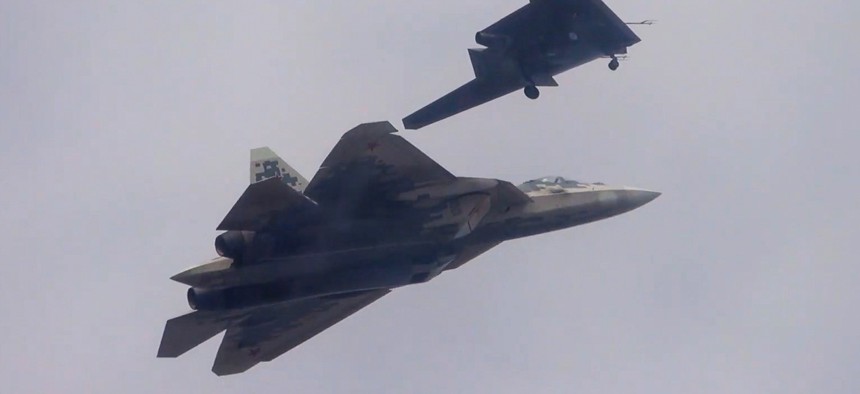
A Russian Sukhoi S-70 Okhotnik heavy UCAV and Sukhoi Su-57 fighter jet made their first paired flight in September 2019. TASS
Russia Is Working to Pair Combat Jets and Drones, Too
In moves to match the U.S. military, experiments are aimed at producing mixed air regiments that are tied into a wider battlefield network.
The United States isn’t the only country working to pair fighter jets with heavy drones. Russia is looking to bring together its advanced Sukhoi Su-57 fighter and its S-70 Okhotnik heavy reconnaissance and strike drone in mixed air regiments, according to Russian news outlet Izvestia.
The Su-57, first flown in 2010, is Russia’s most advanced fighter. Russia expects to have 76 of them by 2028, according to CNA analyst Sam Bendett. The S-70 Okhotnik is still in development. The two were “ designed as interoperable as far as their weapons systems go, and their communications,” said Bendett.
He says mixing strike drones and fighter jets is a high priority for the Russian Ministry of Defense. Last December, Deputy Defense Minister Alexey Krivoruchko touted efforts to enable UAVs to operate in airspace shared with manned aircraft, to develop UAV swarms, and to add elements of artificial intelligence to UAV control systems.
Last month, Russia began testing new “networked warfare” concepts to link its weapons in a battle web, according to Russian news site RIA Novosti.
These efforts are taking place alongside parallel ones in the United States. The Air Force’s XQ-58A Valkyrie drone program seeks to build stealthy, relatively -low- cost drones to fight alongside the far costlier F-35 and F-22 combat jets. The Air Force Research Lab completed a successful flight test last December.
A DARPA program called Gremlins is developing drones that can be deployed and recaptured by manned aircraft; it too saw a successful flight test in December.
These efforts to integrate fighter jets and strike drones fits into Joint All-Domain Command and Control, or JADC2, a ten-year effort to integrate weapons and vehicles in a single data web across military service and across the air, land, sea, space and cyberspace.





